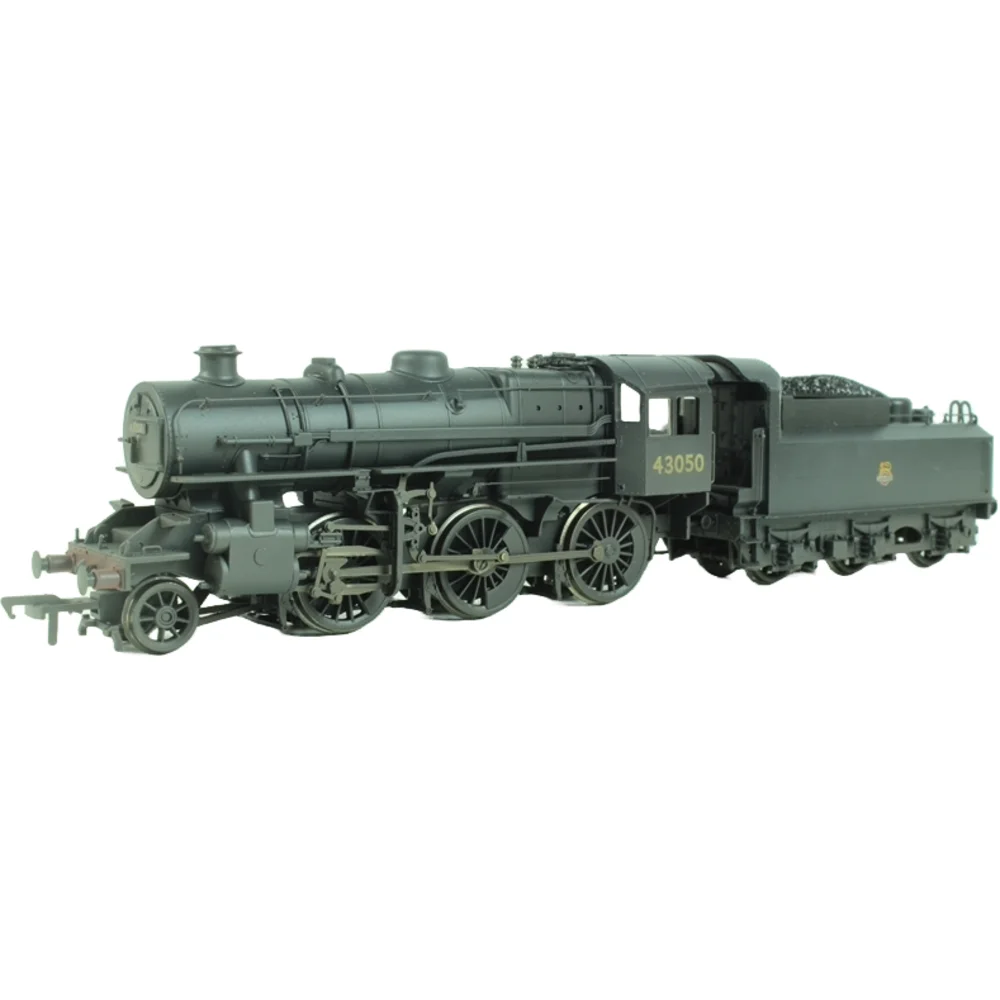Bachmann 32-575K
London, Midland & Scottish Railway Ivatt Class 4 2-6-0 43050 British Railways Black with Early Emblem
Tooling
Bachmann Branchline introduced its LMS Ivatt Class 4 2-6-0 model in 2005, representing the mixed-traffic ‘Mogul’ locomotives designed by H.G. Ivatt for the LMS and later BR. The prototype was built between 1947 and 1952 and became a versatile workhorse across the network. Bachmann’s tooling aimed to deliver a highly detailed OO gauge rendition for enthusiasts seeking accuracy and reliability.
Tooling Features
- Scale: OO gauge (1:76).
- Construction: Combination of plastic and metal components for durability and weight.
- Detailing: Factory-fitted separate parts including handrails, injector pipework, lamp irons, tablet catcher equipment, tender ladder, and turned brass safety valves and whistle. Cab interior fully detailed with glazing.
- Finish: Chemically blackened wheels and fluted connecting rods with an oily finish for realism.
- Couplings: NEM pockets with tension-lock couplers; cosmetic hooks supplied.
Mechanical & Electrical
- Drive: Loco-driven mechanism with a 3-pole motor located in the locomotive body.
- Pickups: On driving wheels only; 2-rail DC operation.
- Minimum Radius: Recommended Radius 2 (approx. 18 inches).
- Weighting: Integrated within chassis for improved adhesion.
- Working Features: Functional roof vent; sprung front bogie for smooth running.
DCC Capability
- DCC Ready with 8-pin socket.
- No factory provision for sound speaker; sound installation requires modification.
Liveries Produced
- LMS Black (pre-nationalisation).
- BR Plain Black.
- BR Black with Early Emblem.
- BR Black with Late Crest.
- BR Lined Black variations, including weathered and limited editions.
Reviews & Commentary
Initial reviews praised the model’s fine detailing and accurate proportions, particularly the cab and tender features. Performance was generally smooth, with good slow-speed control and adequate haulage for typical layouts. Criticism focused on limited space for DCC sound installation and occasional tightness when removing the body for decoder fitting. Enthusiasts noted that the model runs best on curves larger than the minimum recommended radius for visual realism.
Media & Social Media
The Ivatt Class 4 tooling has featured in numerous YouTube reviews and running sessions, often highlighted for its authentic appearance and reliable mechanism. Collectors appreciate the breadth of liveries and occasional limited editions, making it a popular choice for LMS and BR-era layouts.
Interesting Notes
- The prototype locomotives were nicknamed “Mucky Ducks” and “Flying Pigs,” a heritage reflected in enthusiast discussions.
- Despite being nearly two decades old, the tooling remains competitive thanks to its strong detailing and robust design.
Class & Prototype
- Class: London, Midland & Scottish Railway Ivatt Class 4 2-6-0
- Traction: Steam
- Built: 1947-1952
- Total Built: 162
- Running Number: 43050
Operator & Livery
- Operator: British Railways
- Livery: Black with Early Emblem
- Era: 4 - British Railways Early Emblem
British Railways transformed Britain's fragmented rail network into a unified national system following nationalisation on 1st January 1948. Created from the "Big Four" companies under the Transport Act 1947, BR operated most of Great Britain's railways until rebranding as British Rail in 1965, managing over 20,000 route miles and inheriting nearly 20,000 locomotives of diverse designs.
The organisation pioneered standardisation through its revolutionary BR Standard locomotive programme (1951-1960), producing 999 advanced steam engines under Robert Riddles' direction. These included the versatile Britannia Pacifics, mighty 9F freight engines, and mixed-traffic classes that incorporated the best features from all predecessor companies. The 1955 Modernisation Plan accelerated diesel and electric traction development, creating fascinating mixed-traction operations.
Notable achievements included establishing unified locomotive classification systems, introducing distinctive corporate liveries, and managing the complex transition from steam to modern traction. BR's six regional structure preserved operational diversity whilst enabling standardisation of practices, signalling, and rolling stock that had eluded private enterprise for over a century.
The BR era represents steam traction's final flowering alongside emerging diesel technology, creating unparalleled locomotive variety. Today, this heritage remains highly popular with railway enthusiasts through extensive preserved fleets, heritage railway operations, and comprehensive model ranges from manufacturers like Hornby, Bachmann, and Dapol, making BR subjects essential for authentic post-war British railway modelling across all scales.
British Railways' plain black livery was designated specifically for freight and shunting locomotives from 1948, representing the most economical and practical finish for inherently dirty industrial machines. During the early nationalisation period, many locomotives were simply patch-painted over old company markings with black paint, which quickly weathered to match the existing finish as these engines were rarely cleaned. The "Lion and Wheel" emblem (nicknamed the "Cycling Lion") was introduced from December 1948 and applied to plain black locomotives from early 1949, featuring a lion standing over a large railway wheel with "British Railways" lettering across the centre.
The emblem was produced in three sizes and always faced forward, positioned centrally on tender sides or tank sides, with regional preferences evident—the Western Region favoured larger emblems whilst other regions used smaller versions. Plain black locomotives retained red buffer beams and received white "BRITISH RAILWAYS" lettering in Gill Sans style before the emblem's introduction. Some former company locomotives, particularly ex-GWR shunting engines, retained their original lettering well into the early 1960s as they didn't require renumbering and received minimal attention. This utilitarian livery remained standard for freight operations until the mid-1950s emblem change, making it essential for authentic early BR period modelling of goods yards, collieries, and industrial operations.
